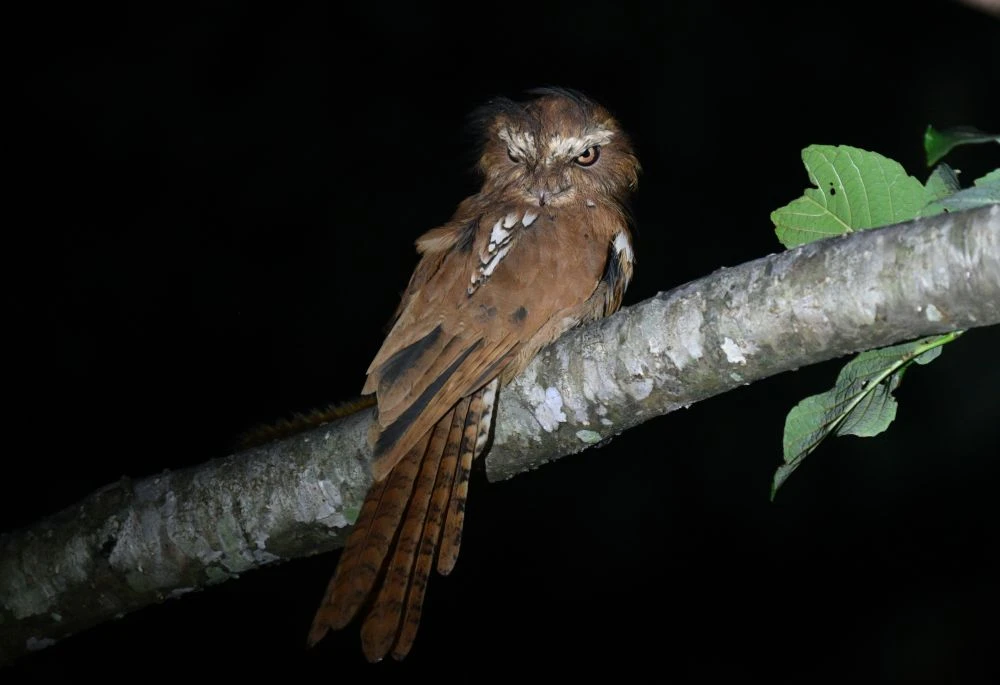Photograph: Rofikul Islam

Mohammed Thanvir
India is among the nations with the highest levels of biodiversity. One of the locations where intriguing and lesser-known animals live is in northeastern India. It includes Arunachal Pradesh, Assam, Manipur, Meghalaya, Mizoram, Nagaland, Sikkim, and Tripura. Particularly well-known for their amazing biodiversity, the Mishmi Hills in Arunachal Pradesh are home to a diverse range of flora and fauna. The Hodgson frogmouth (Batrachostomushodgson) is one of them. It is a fascinating nocturnal bird that is difficult to see in the forest because of its mysterious morphology, as well as one of the most successful survivors due to its exceptional adaptation to its environment.
Master of confusion:
The Hodgson frogmouth's mysterious feathers make it one of the most camouflaged birds. Similar to its feathers to tree bark, predators may mistake it for a tree part. This bird uses the broken branch strategy to escape from the predator, which means the frogmouth bird appears to be attempting to blend in with the branch as it stands erect and stretches upward. It tilts its head slightly, its eyes barely open, and then it freezes, unmoving, merging with the tree, creating the ideal image of a shattered limb. All of this increases the bird's survival rate against predators.
Master of hunting
Batrachostomus is a ghost-like predator because it catches its victim by surprise and stealth, pouncing from a tree or perch high above the ground and waiting for the prey to get within striking distance. Utilizing their enormous frog-like gape and flattened hooked bill, they hunt rodents, tiny vertebrates, and nocturnal arthropods.

Master of sound
This bird's physical parts resemble birds except for its mouth, which resembles a frog's. So, the bird's scientific name is Batrachostomus Hodgson, which means "Batrachos (frog) and stomus (mouth) = frog mouth" (Hodgson = a British naturalist who named this bird). When it uses this mouth, it produces a soft whistle or repetitive clicking sound, adding to the spooky nighttime soundscape of the forests. Later, they discovered that this sound is used for mating calls and that it is a bird with a long-term pair bond (monogamy), similar to the bald eagle.
Habitat and breeding behavior
The majority of Hodgson's frogmouths can be found in temperate forests, including mixed coniferous tropical rainforests or broad-leaved evergreen forests, throughout subtropical and tropical Asia, including Bangladesh, Bhutan, China, India, Laos, Myanmar, Thailand, and Vietnam. In contrast to other frogmouth species, Hodgson builds smaller, cup-shaped, soft, padded nests lined with its own down and lays two to four white eggs. The female will incubate the eggs during evening twilight and for one to two hours before dawn, while the male will do the same in the morning. The incubation period lasts for roughly 30 days.
Conclusion:
The species itself was a truly secretive icon, being almost entirely unknown to scientists and birdwatchers. Deforestation and lack of research threaten its survival by shrinking its foraging and breeding grounds. Researching the Hodgson frogmouth could show new views into nighttime ecology, birds’ evolution, and camouflage methodologies. The method to preserve this enigmatic species is to educate people about its ecological adaptation and raise awareness. Conservation efforts continue; increasing awareness about such amazing cameos is vital to preserving the rich biodiversity of India’s northeast.
Mohammed Thanvir is a dedicated wildlife enthusiast and biology educator with a Master's in Zoology and a B.Ed. in Biological Science.




